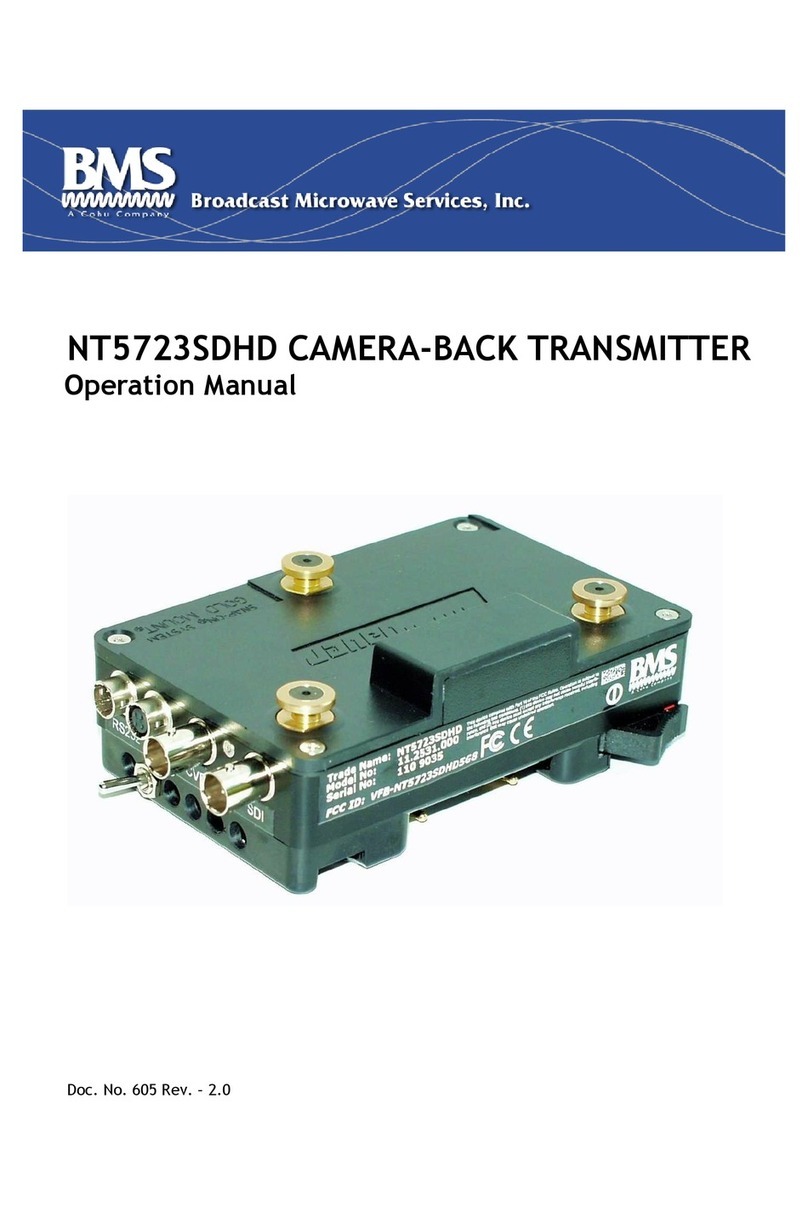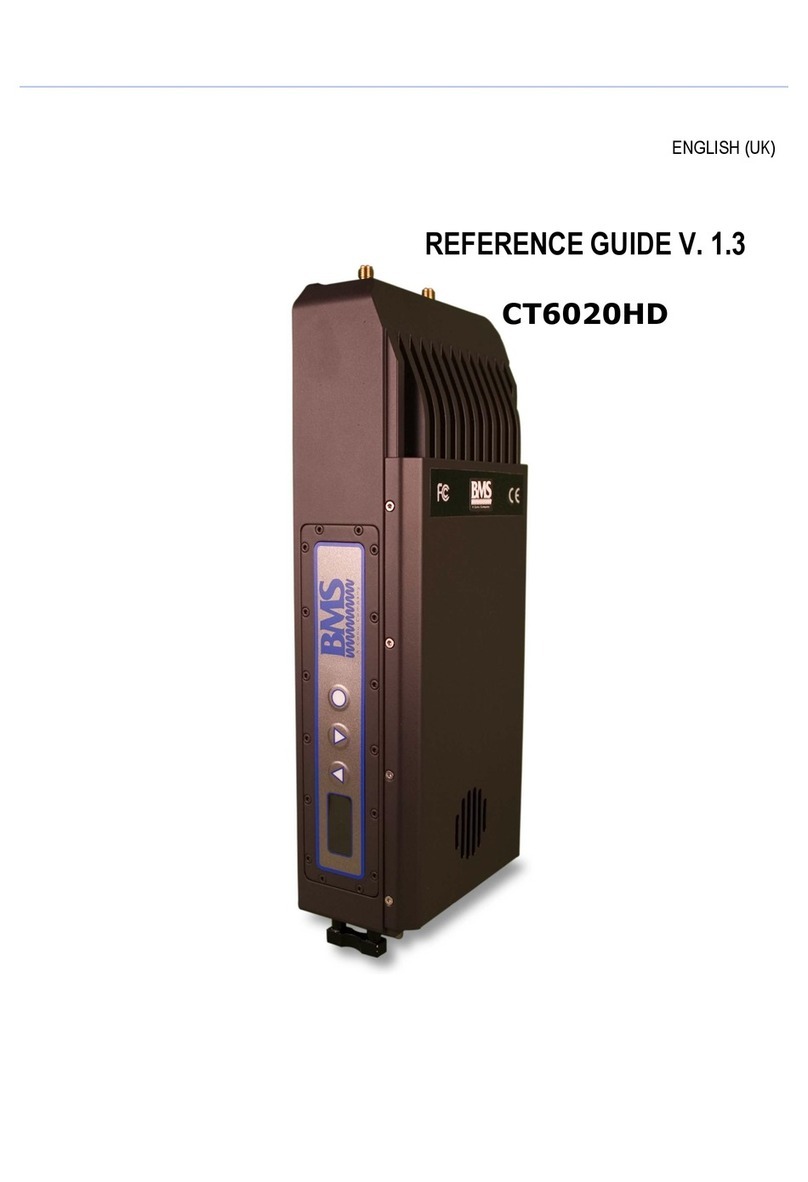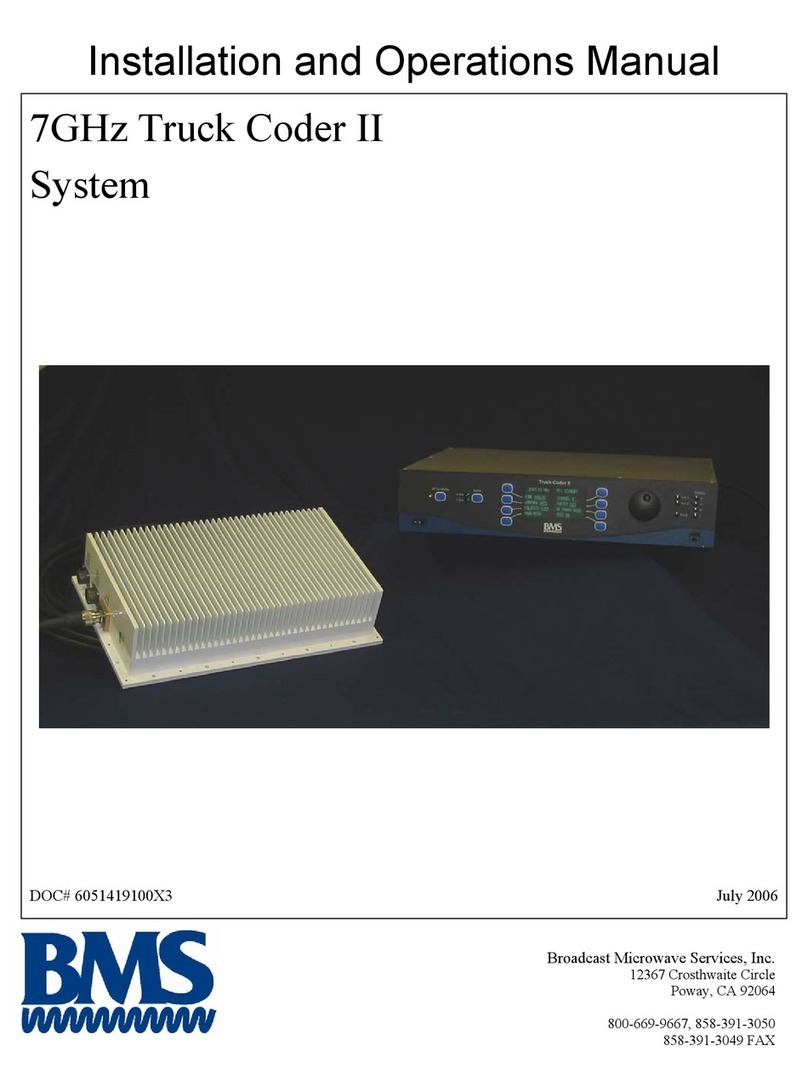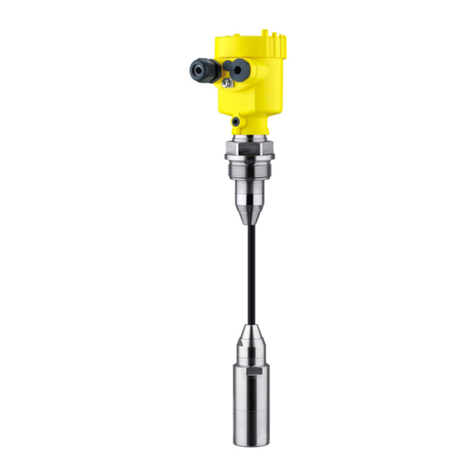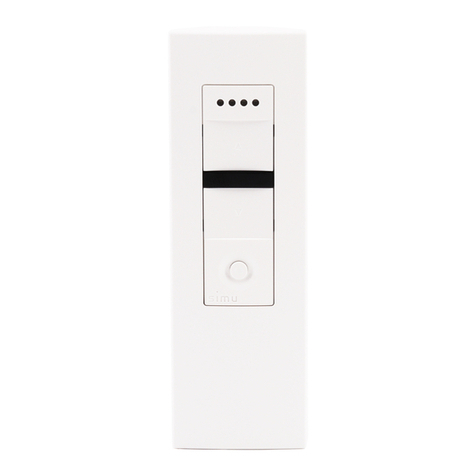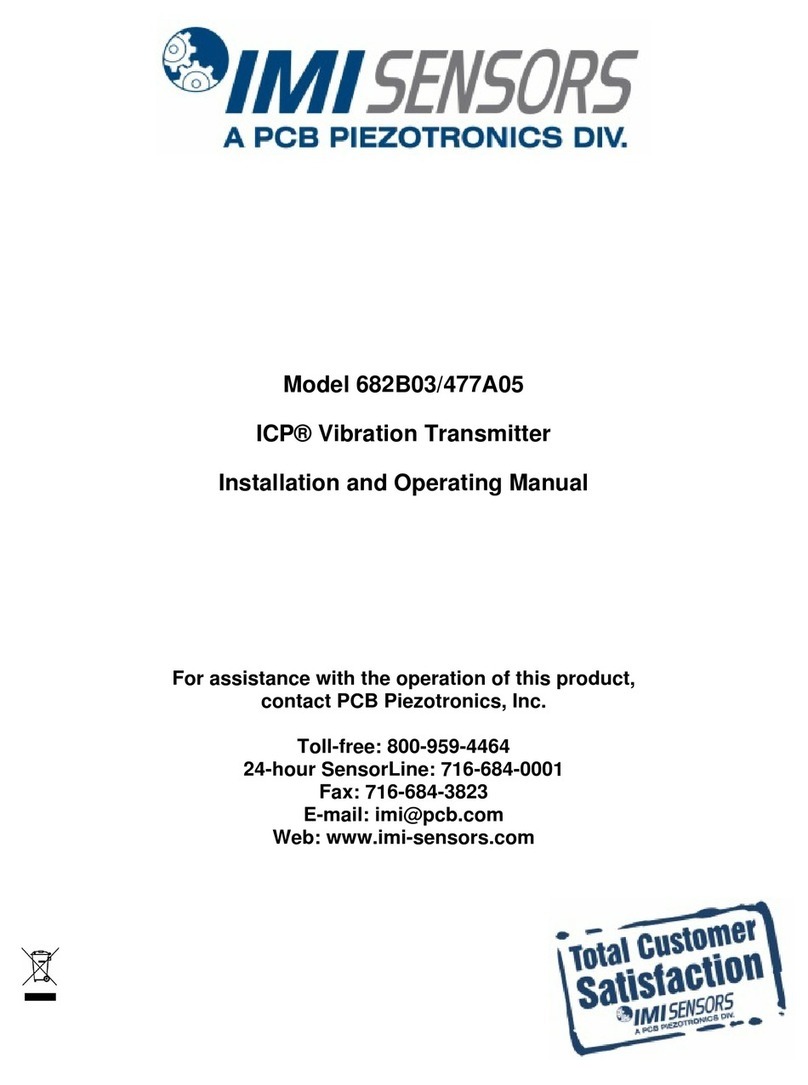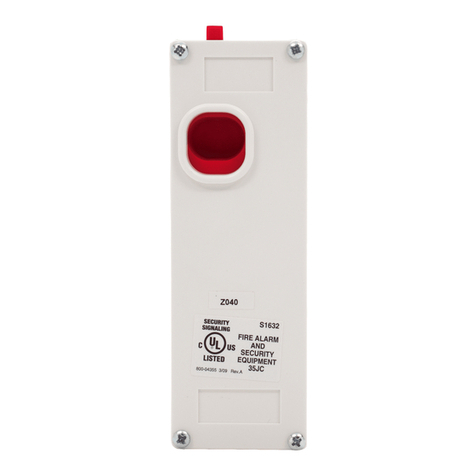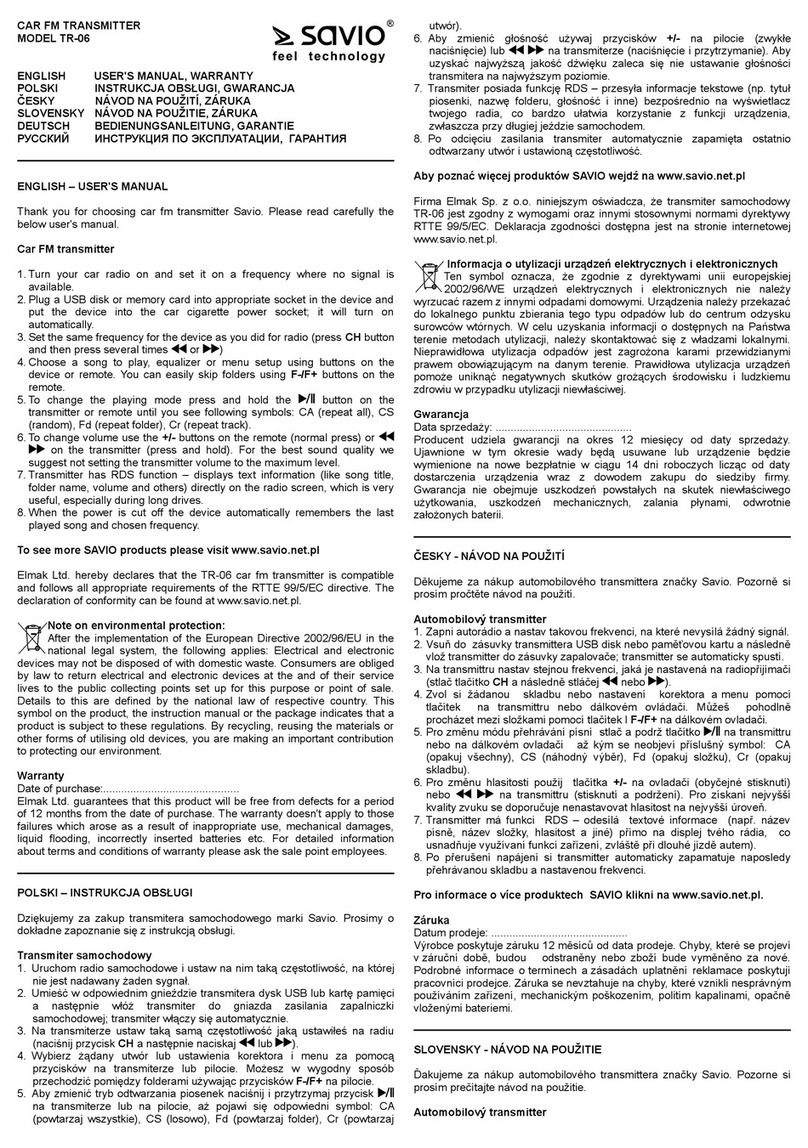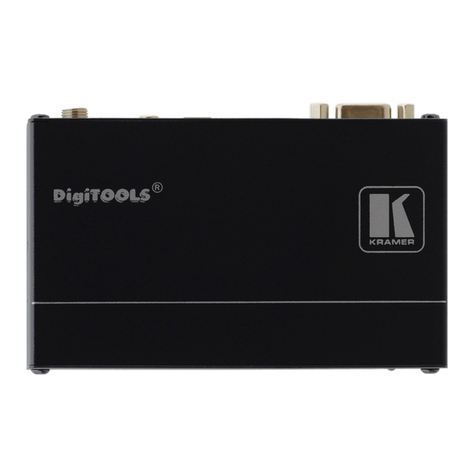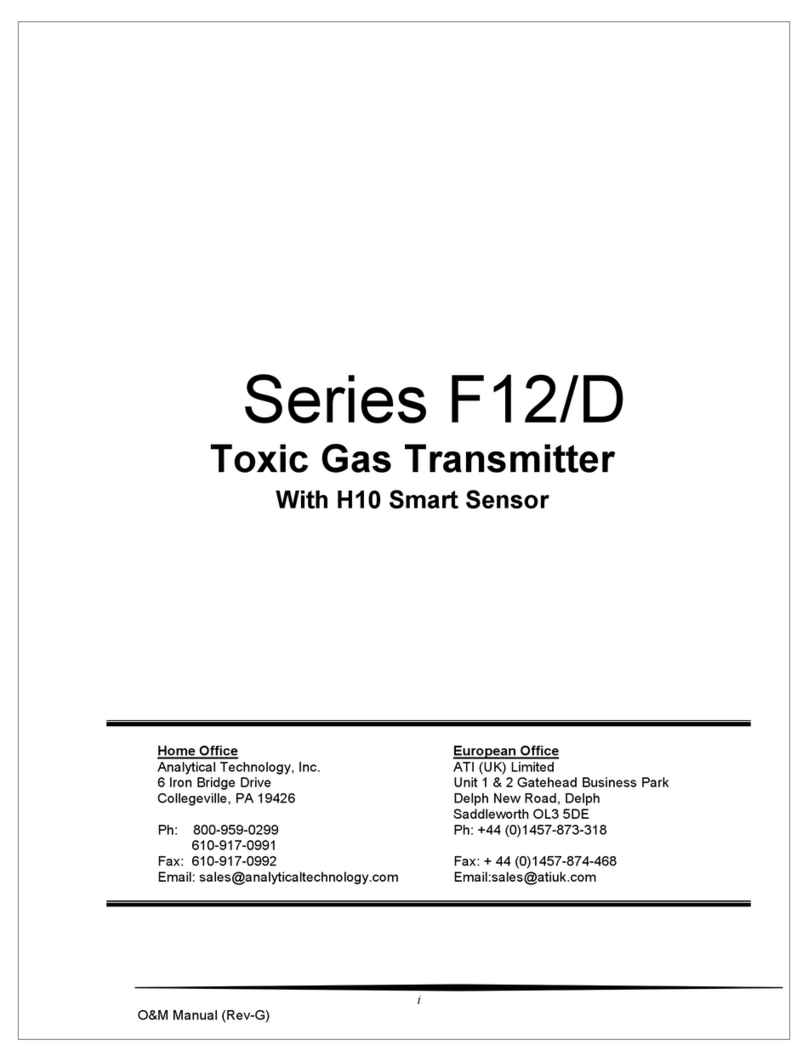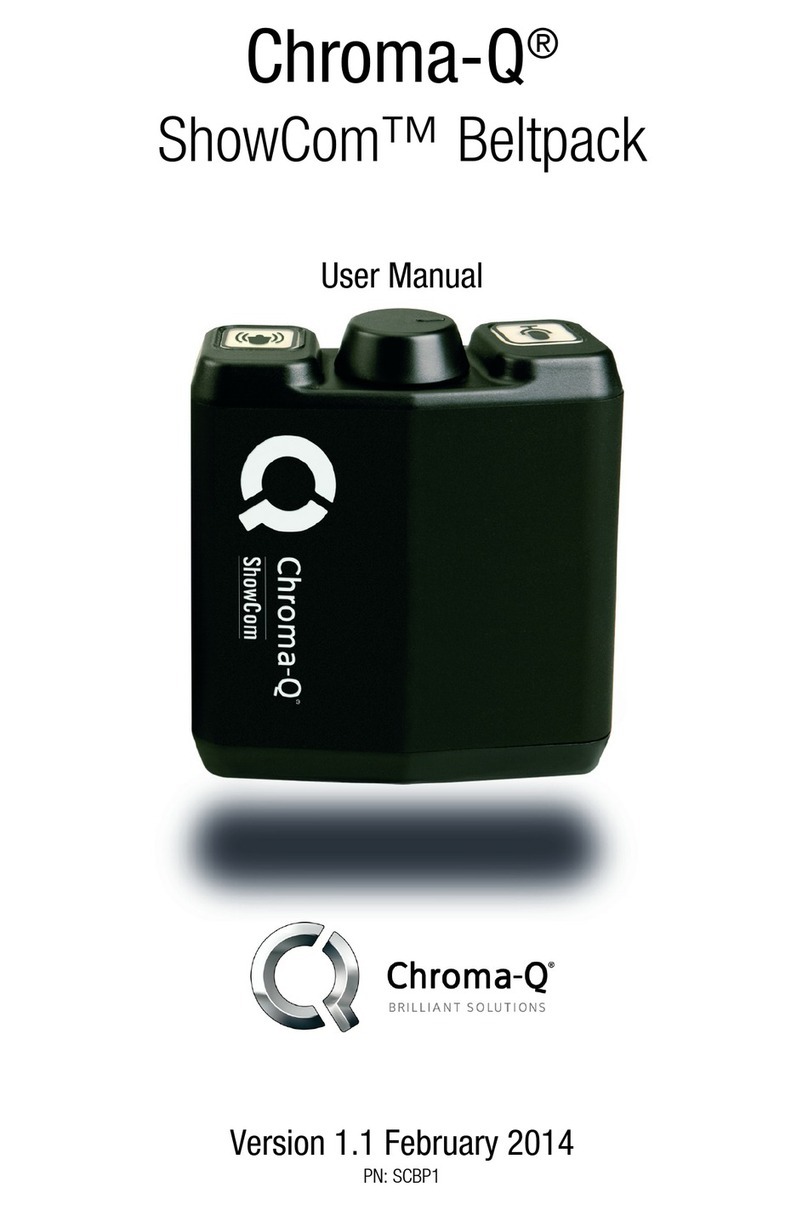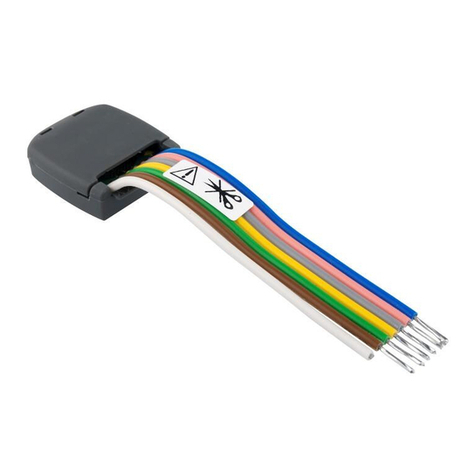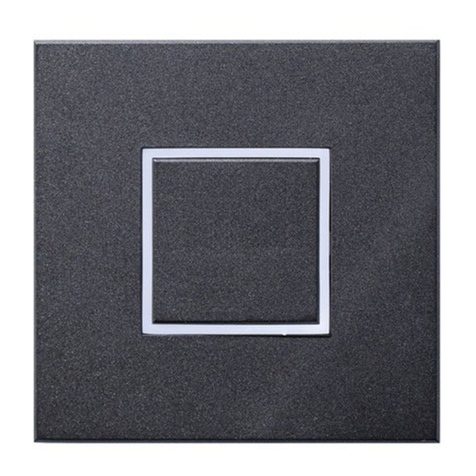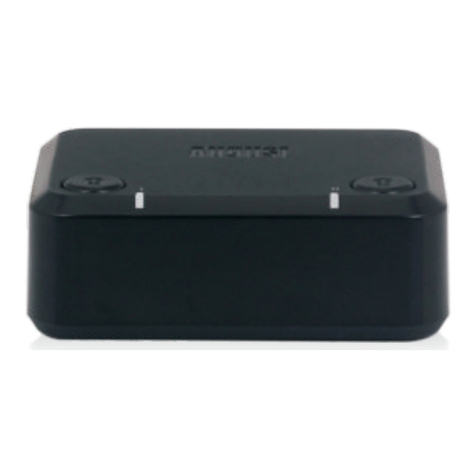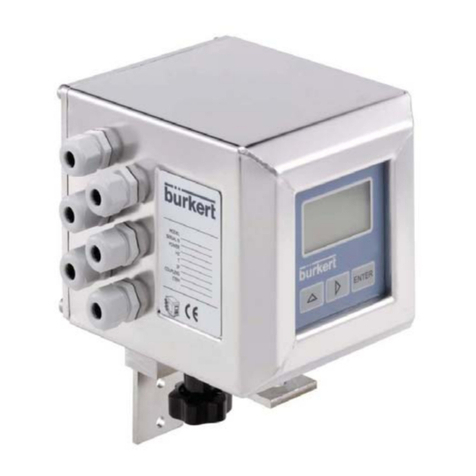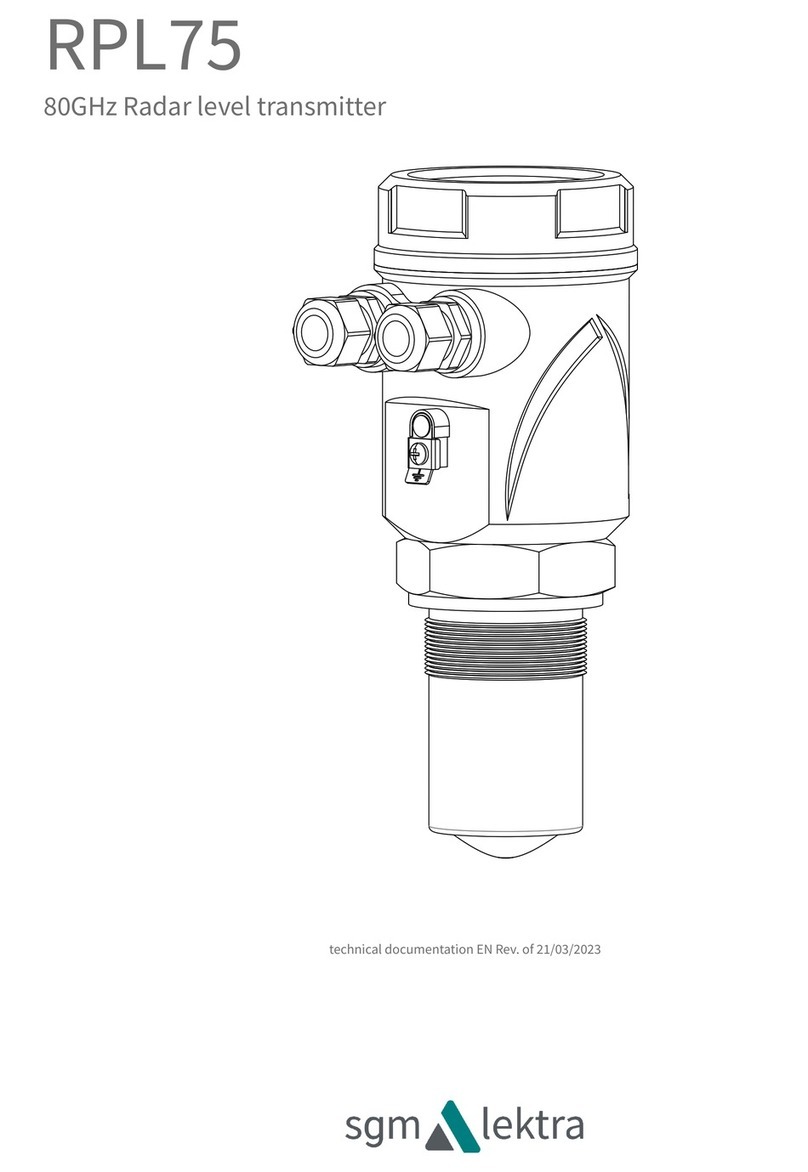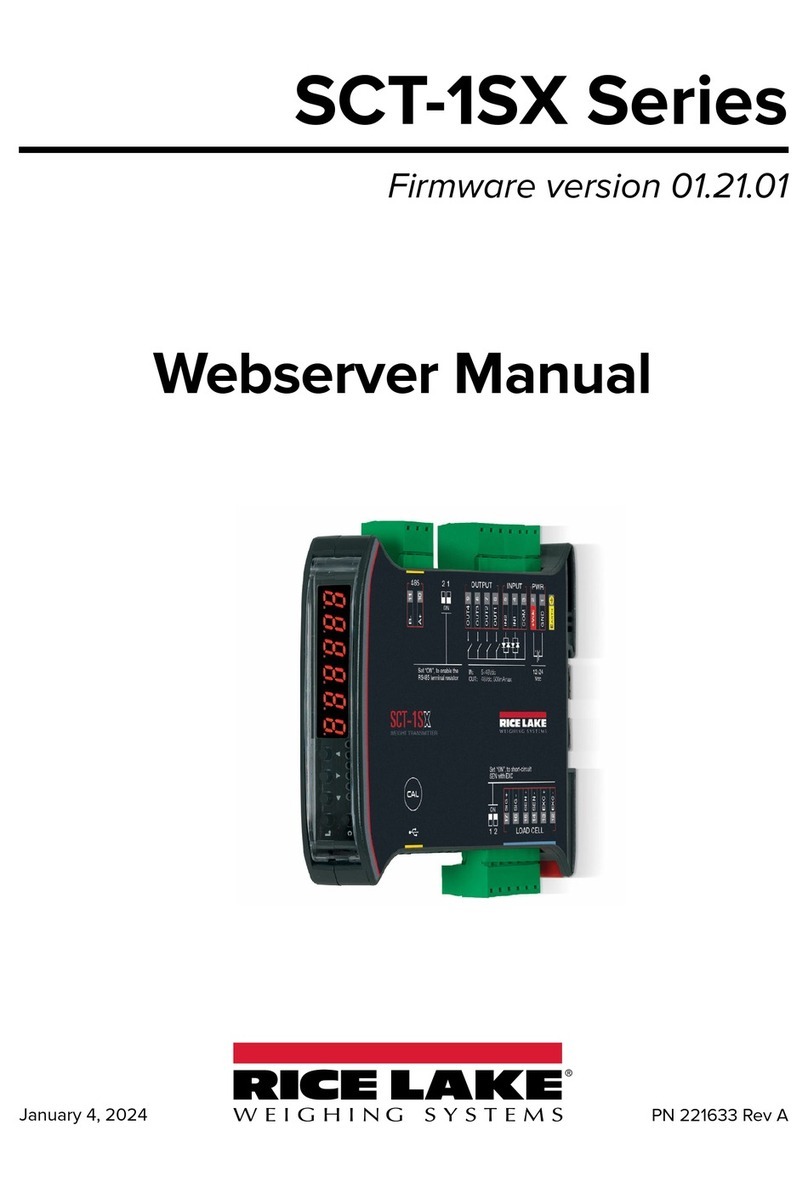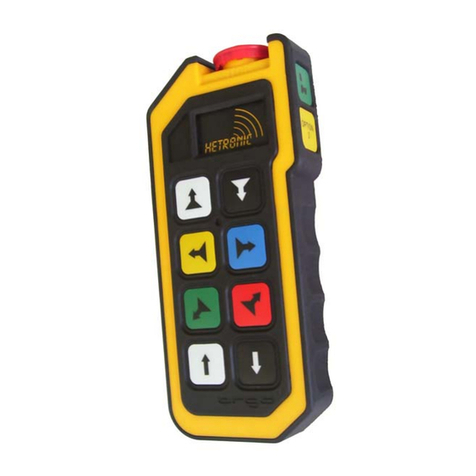BMS HELI-CODER 4 User manual

HELI-CODER™ 4 TRANSMITTER
Operation Manual
Doc. No. 6051452100 Rev.C1

Broadcast Microwave Services, Inc. | www.bms-inc.com
Corporate Headquarters
12367 Crosthwaite Circle | Poway, CA 92064 US
Phone: +1 800-669-9667 (US) | +1 (858) 391-3050 | Fax: +1 (858) 391-3049
BMS European Office
Schwalbacherstr. 12 | 65321 Heidenrod-Kemel GERMANY
Phone: +49-6124-7239-00 | Fax: +49-6124-7239-29
2012 Broadcast Microwave Services. All rights reserved.
This document and the information contained in it is the property of Broadcast Microwaves Services, Inc. and may be the subject
of patents pending and granted. It must not be used for commercial purposes nor copied, disclosed, reproduced, stored in a
retrieval system or transmitted in any form or by any means (electronic, mechanical, photocopying, recording or otherwise),
whether in whole or in part, without BMS prior written agreement.
This printed document is uncontrolled and is for reference only. Users are to verify that this is the latest approved version.

Heli-Coder 4 Transmitter Operation Manual | Doc. No. 6051452100 Rev. C
Broadcast Microwave Services, Inc. i
Document Revision History
DRAFT
November 2011
Preliminary Release
April 2012
Preliminary Update
May 2012
Initial Release
June 2012
Rev -
Add Additional Figures and Software Installation Section.
December 2012
Rev A
Amend DO-160 compliance table
July 2013
Rev B
Amend for references to encryption options
December 2013
Rev C
Amend FCC & Channel Bandwidth
June 2014
Rev C1
Conventions Used in This Manual
1.
NOTE: Notes provide supplementary information. They are highlighted for emphasis, as in this example, and
are placed immediately after the relevant text.
CAUTION: Cautions give information which, if strictly followed, will prevent damage to equipment or other
goods. They are boxed for emphasis, as in this example, and are placed immediately preceding the point at
which the reader requires them.
WARNING: Warnings give information which, if strictly observed, will prevent personal injury or death, or
damage to personal property or the environment. They are boxed and shaded for emphasis, as in this example,
and are placed immediately preceding the point at which the reader requires them.
2. ATTENTION!
DO NOT use right-angle connectors or adapters on the RF Power Out cable assemblies. Right-angle
connectors may have significant RF power loss at the operating frequencies of this system.
3.
FOR ALL BMS TRANSMITTERS –Operation of a BMS transmitter product generally requires a license. It is the
responsibility of the user to obtain all required operating licenses.
4.
ONLY FOR PRODUCTS AWAITING FCC CERTIFICATION –This device has not been authorized as required
by the rules of the US Federal Communications Commission. This device is not, and may not be, offered for
sale or lease, or sold or leased, in the US until authorization is obtained.
Acceptance Test Procedure (ATP) test data results by product serial number are typically shipped with all units
and indicate the equipment to be operating within advertised specifications. Contact BMS to request this data.
Read and Follow Instructions! All safety and operating instructions should be read before this product is
operated. All operating and use instructions should be followed. This manual should be retained for future
reference.
EMC Compliance –This equipment is certified to the EMC requirements detailed in the technical specifications.
To maintain this certification, only use the cables supplied or if in doubt contact BMS Customer Service.

Broadcast Microwave Services, Inc. ii
PAGE INTENTIONALLY LEFT BLANK

Broadcast Microwave Services, Inc. iii
Contents
1INTRODUCTION ..............................................................................................................................................1
2SAFETY............................................................................................................................................................2
3PRODUCT DEFINITION ...................................................................................................................................4
3.1 Product Specifications..............................................................................................................................2
3.2 Model Information.....................................................................................................................................2
4CONNECTORS AND PINOUTS.......................................................................................................................3
5INSTALLATION................................................................................................................................................7
5.1 Locating the Components.........................................................................................................................7
5.2Fasteners .................................................................................................................................................8
5.3 Mounting the Transmitter..........................................................................................................................8
5.4 Wiring Connections and Signal Interfaces..............................................................................................11
5.4.1 Power Input (J2) ................................................................................................................................................. 11
5.4.2 Radio Frequency Output (RF Out) (J5) .............................................................................................................. 11
5.4.3 Serial Digital Video Input (J12)............................................................................................................................ 11
5.4.4 Composite Video (CVBS) Input (J9).................................................................................................................... 11
5.4.5 ASI Input............................................................................................................................................................. 11
5.4.6 ASI Output.......................................................................................................................................................... 11
5.4.7 Audio Input ......................................................................................................................................................... 11
5.4.8 GPS.................................................................................................................................................................... 11
5.4.9 Data Wayside Input ............................................................................................................................................ 12
5.4.10 KLV Data ....................................................................................................................................................... 12
5.4.11 Auxiliary Data................................................................................................................................................. 12
5.4.12 Ethernet ......................................................................................................................................................... 12
5.4.13 USB ............................................................................................................................................................... 12
5.4.14 ARINC ........................................................................................................................................................... 12
5.4.15 Control ........................................................................................................................................................... 12
6TRANSMITTER OPERATION ........................................................................................................................13
6.1 Operating the Transmitter with the DLC50 Control Panel ......................................................................13
6.2 DLC50 Menu Structure...........................................................................................................................14
7BMS Geo-Point™ System.............................................................................................................................16
7.1 Geo-Point System Description ...............................................................................................................16
7.2 Enabling Geo-Point™.............................................................................................................................16
8SOFTWARE INSTALLATION ........................................................................................................................17
9ACCESSORIES..............................................................................................................................................18
10 ADDITIONAL REFERENCES ........................................................................................................................18
11 REGULATORY...............................................................................................................................................19
11.1 Electromagnetic Compliance..................................................................................................................19
11.2 FCC........................................................................................................................................................19
11.3 Environmental Qualifications ..................................................................................................................19
12 PREVENTIVE MAINTENANCE......................................................................................................................20
12.1 Maintenance Schedule...........................................................................................................................20
12.2 Maintenance Procedures........................................................................................................................20
12.3 Spare Parts ............................................................................................................................................20
13 REPAIR SERVICE AND WARRANTY ...........................................................................................................20
13.1 Customer Service...................................................................................................................................21
14 GLOSSARY....................................................................................................................................................22
15 CONNECTION AND WIRING DIAGRAMS ....................................................................................................24

Broadcast Microwave Services, Inc. iv
List of Figures
Figure 1. Heli-Coder 4 Transmitter ............................................................................................................................4
Figure 2 HC4 Front Panel Labels ..............................................................................................................................3
Figure 3 Transmitter mounting bracket .....................................................................................................................8
Figure 4 HC4 positioned in aircraft mounting bracket ................................................................................................8
Figure 5 HC4 Outline Drawing ...................................................................................................................................9
Figure 6 CT-A-MP HC4 Mounting Plate - Dimensioned Drawing............................................................................10
Figure 7 DLC50-A AVIONICS CONTROL PANEL (FRONT) ...................................................................................13
Figure 8 DLC50-A AVIONICS CONTROL PANEL (BACK)......................................................................................13
Figure 9 DLC50 Commands ....................................................................................................................................14
Figure 10 DLC50 Outline .........................................................................................................................................15
Figure 11 Product Label...........................................................................................................................................21
Figure 12 Typical airborne installation diagram (without TAA-101 Antenna Actuator) .............................................25
Figure 13 Wire Hook-Up Diagram for HC4 System (without TAA-101 Antenna Actuator) .......................................26
Figure 14 Typical airborne installation diagram (including TAA-101 Antenna Actuator) ..........................................27
Figure 15 Wire Hook-Up Diagram for HC4 System (including TAA-101 Antenna Actuator) ....................................28
List of Tables
Table 1 MPE per FCC OET65 (1.5 GHz to 100 GHz)................................................................................................3
Table 2. Product connector descriptions in Figure 1..................................................................................................4
Table 3. HC4 connectors ...........................................................................................................................................3
Table 4. Connector pin outs.......................................................................................................................................4
Table 5. HC4 Component Placement Planning .........................................................................................................7

Heli-Coder 4 Transmitter Operation Manual | Doc. No. 6051452100 Rev. C
Broadcast Microwave Services, Inc. 1
1 INTRODUCTION
This document provides instructions for installation, operation and maintenance of the Heli-Coder 4 (HC4) COFDM
Transmitter controlled by a DLC50 Downlink Control Panel.
BMS offers a wide selection of airborne products to meet the video and data requirements of today’s real world
applications. The Heli-Coder™ 4 (HC4) together with the DLC50 controller provides a simple, powerful solution
containing everything needed for high-quality, reliable transmission. This includes the video encoder, modulator,
up-converter and high-power amplifier and an intuitive powerful control interface (see Figure 1.).
Standard COFDM modulation offers excellent performance in urban and non-line of sight environments with
significant multipath. The HC4 also provides an integrated GPS data interface that reduces the components
needed to integrate location data into tracking systems. The HC4 provides everything required to achieve 10 W
output power in an ultra-compact case. The DLC50 control panel allows the HC4 unit to be mounted remotely
within the avionics bay while providing full control from the flight deck.
With the flexibility of MPEG-2 and H.264 compression, the HC4 efficiently handles SD or HD video and can be
configured to deliver high speed data as an ethernet radio. The HC4 is also Geo-Point™ capable. Geo-Point™
uses metadata supplied by the equipment serving as the video source and allows the display of bearing and
distance to the location shown on the screen in real time. (Geo-Point™ requires a compatible receiver.)
NOTE: The standard version of the HC 4 is configured to be controlled by a DLC50 Control Panel. Custom
configurations and control schemes may be supported. Contact BMS regarding your operational requirements and
the range of solutions BMS offers.
Broadcast Microwave Services (BMS) is a leader in wireless digital microwave technology providing innovative
products for the television broadcast, video, telemetry and surveillance industries. A wholly owned subsidiary of
Cohu, Inc., BMS designs and manufactures a comprehensive line of microwave communications equipment for
broadcasting sports venues, law enforcement and military applications. BMS also builds and integrates the
command and control centers to provide fully functioning, complex, end to end digital systems.
For the latest product and system information please visit www.bms-inc.com.
Broadcast Microwave Services, Inc.
12367 Crosthwaite Circle
Poway, CA 92064
Tel: +1 (858) 391-3050
Toll free (US): 800-669-9667
Fax: +1 (858) 391-3049
Email:[email protected]
www.bms-inc.com

Heli-Coder 4 Transmitter Operation Manual | Doc. No. 6051452100 Rev. C
Broadcast Microwave Services, Inc. 2
2 SAFETY
WARNING- RF Hazard: Non-Ionizing RF Emission
Operators of this equipment should be familiar with basic RF equipment operation and safety concepts. Users
must consider many unique factors to maintain RF safety. We offer the following guidelines with the
recommendation that each individual and organization establish an RF Safety and Awareness program based on
their combination of hardware and usage environment.
Radiation Exposure
The frequencies present in BMS equipment produce non-Ionizing radiation. The FCC reference document
regarding RF exposure limits is OET Bulletin 65 and can be viewed by visiting the FCC web site (www.fcc.gov ) or
by clicking here;
http://www.fcc.gov/Bureaus/Engineering_Technology/Documents/bulletins/oet65/oet65.pdf
(Link valid as of 6/25/2012)
We also reference EU Standard EN 50392 (02-2004). BMS references these standards as reasonable guidelines.
The OET 65 document sets maximum permitted exposure (MPE) and is widely cited within the U. S. and Canada.
Exposure is divided into two categories, “controlled” and “uncontrolled” environment. The uncontrolled
environment is the harshest criteria and applies to exposure where you may not be aware and/or cannot control
the exposure. Examples are where a residence is located near a cell site or other radio tower. You live there,
cannot remove yourself from the field and cannot control the RF. Exposure is long term and not in your control.
The “controlled environment” applies to most professional radio users. It is assumed they are trained in RF Safety,
they are aware there is an RF field, exposure is limited by transmission duty cycles, the flight or testing ends, hang
up the cell phone, put up the walkie-talkie, etc.
BMS recommends that operators use the uncontrolled exposure category from OET 65 as it applies to an
uncontrolled environment; a maximum power density limit of 1mW/cm².
The limit table from Bulletin 65 is reproduced below. X axis is frequency and y axis is mW/cm².

Heli-Coder 4 Transmitter Operation Manual | Doc. No. 6051452100 Rev. C
Broadcast Microwave Services, Inc. 3
Use the formula from OET65 to determine the minimum recommended distance according to your individual usage
circumstances.
Your organization should develop an understanding of its unique RF usage and create a plan to train personnel
regarding recommended exposure limits according to the FCC and EU recommendations.
General Safety Rules;
a) Do not operate the transmitter or power amplifier with covers removed.
b) Never walk in front of directional antennas when radiating.
c) Switch off supplies before removing covers or disconnecting any RF cables, and before inspecting damaged
cables or antennas.
d) BMS recommends returning the HC4 to the factory for service or repair.
In addition you can limit your exposure by raising awareness and using some common sense rules.
Default to low power if available using hi-power only as required.
Never stand in front of a transmitting directional antenna.
Limit transmission duty cycles (turn on/off as needed).
Table 1 MPE per FCC OET65 (1.5 GHz to 100 GHz)
TRANSMITTER OUTPUT (w)
10
ANTENNA GAIN dBi
0
2
4
6
9
11
14
22
UNCONTROLLED ENVIRONMENT:
MINIMUM PERMISSABLE
DISTANCE INCHES
1.005 mW/cm2
11.08
13.95
17.56
22.10
31.22
39.31
55.52
139.47
CONTROLLED ENVIRONMENT:
MINIMUM PERMISSABLE
DISTANCE INCHES
(5.005 mW/cm2)
4.96
6.25
7.87
9.91
13.99
17.61
24.88
62.50
NOTE: Calculations do not factor reflections

Heli-Coder 4 Transmitter Operation Manual | Doc. No. 6051452100 Rev. C
Broadcast Microwave Services, Inc. 4
3 PRODUCT DEFINITION
Figure 1. Heli-Coder 4 Transmitter
Table 2. Product connector descriptions in Figure 1
1
GPS Antenna Input
2
28VDC Power
3
Ethernet port
4
Communications Port Connector –RS-232
5
RF Output (N-type)
6
Audio Input
7
Control cable Input (from DLC50 Control Panel)
8
ARINC Connector (Reserved for future use)
9
Analog Video Input (CVBS composite video)
10
ASI (Asynchronous Serial Interface) video out
11
ASI (Asynchronous Serial Interface) video in
12
HD/SDI (Digital –uncompressed) video in
13
USB 2.0 port
14
Mounting bracket (x2)
15
Ethernet Status Indicators: Yellow SPEED LED:
ON=100BaseT, OFF=10BaseT Green LINK LED:
Flashing=Valid Ethernet Link, Off=NO Valid
Ethernet Link
16
Power LED: YELLOW when power cable
plugged in; GREEN when unit turned on via
DLC50 Control Panel
Alarm LED: YELLOW indicates a transmit
problem
TxEn LED (Transmit Enabled): YELLOW means
Standby mode; GREEN means transmitter active
9
10
11
12
5
2
3
1
4
6
7
8
13
14
16
15
14

Heli-Coder 4 Transmitter Operation Manual | Doc. No. 6051452100 Rev. C
Broadcast Microwave Services, Inc. 2
3.1 Product Specifications
Frequency
6425-6525 MHz
Channel Bandwidth
6/7/8 MHz
RF Output Power
5W/10 W switchable
Modulation
COFDM 2k
QPSK, 16/64 QAM
FEC 1/2, 2/3, 3/4, 5/6, 7/8
Guard 1/4, 1/8, 1/16, 1/32
Other modulation available; consult factory
Video Encoding
H.264 (MPEG2 option)
Audio Encoding
MPEG 1, Layer II
Channels
Two audios, multiple wayside data channels up to 115kbit/s
Internal Test Generator
Video/Audio Test pattern
Local Control
External Control Panel*
Power Input
24 to 32 VDC (3 A @ 28 VDC)
Consumption
85 W @ RF-Output 10 W
Compliance
CE marked in accordance with EU Low Voltage and EMC Directives
EMC Compliance: EN55022, EN55024
Operating Temp.
-15 to +55° C (5 to +131° F)
Storage Temp.
-55 to +85° C (-67 to +185° F)
Dimensions
5“ W x 9“ D x 6“ H; 270 in.2(127 x 229 x 153) mm
Weight
6 lbs. (2.73 kg)
FCC
This device has not been authorized as required by the rules of the Federal
Communications Commission. This device is not, and may not be, offered for
sale or lease, or sold or leased, until authorization is obtained.
FCC (Part 74) product certification pending.
Regulatory
(See section 10)
FCC Parts 74, 90, 101
RTCA DO-160, designed to be compliant
CE Mark
3.2 Model Information
PART NO.
MODEL
PROFILE
HC4-(xx)-H
H.264, SD/HD
SD=MP@L4 | HD=MP@L4; HP@L4
HC4-(xx)-M
MPEG2, SD/HD
SD=SP@ML; 422@ML | HD=SP@HL
HC4-(xx)-MH
MPEG2/H.264, SD/HD
MPEG2: SD=SP@ML; 422@ML | HD=SP@HL
H.264: SD=SP@L4; HI422@L4 | HD=SP@L4
* where (xx) is center frequency in MHz

Heli-Coder 4 Transmitter Operation Manual | Doc. No. 6051452100 Rev. C
Broadcast Microwave Services, Inc. 3
4 CONNECTORS AND PINOUTS
Figure 2 HC4 Front Panel Labels
Table 3. HC4 connectors
J1
GPS In (with optional DC Bias Out)
TNC(f), 50 ohm
J2
Power In
Souriau 3-pin male 851-02R12-3P50
J3
Ethernet
M12-4 Socket (early model used RJ45)
J4
COMM
RS232 External GPS
RS232 External AAAP
RS232 KLV or Camera Metadata
Tri-Start, Size 11, 13 Socket
J5
RF Out
N(f), 50 ohm
J6
Analog Audio In (2 channels)
D38999-26WC, 35 pin
J7
Control Panel
Souriau (male) 10-pin
J8
ARINC 429 (reserved for future use)
D38999-26 WA355N socket
J9
CVBS In (NTSC, PAL)
BNC(f), 75 ohm
J10
ASI Out
BNC(f), 75 ohm
J11
ASI In
BNC(f), 75 ohm
J12
SDI, HD-SDI In
BNC(f), 75 ohm
J13
USB 2.0
Type A (Host)

Heli-Coder 4 Transmitter Operation Manual | Doc. No. 6051452100 Rev. C
Broadcast Microwave Services, Inc. 4
Table 4. Connector pin outs
GPS J1
610006040, TNC(f), 50 ohm
GPS ANTENNA INPUT
TNC CONN (FEMALE)
50 OHM
HC4
Provides variable DC
bias or none.
SIGNAL
SHIELDING GND
Power Input J2
3-pin SOURIAU (m)
HC 4
A
28VDC
B
GND
C
N/C
ETHERNET J3
M12-4, 4 pin socket
USB 2.0 SERIAL DATA
HC4
SOCKET 1
TD+
SOCKET 2
RD+
SOCKET 3
TD-
SOCKET 4
RD-
SHIELDING
GROUND
COM J4
210069751, Connector Tri-start, Size 11, 13 Socket,
PCB Tail
COM
HC4
1
GND
2
AERO RS232 TX
3
AERO RS232 RX
4
GND
5
TGT DATA RS232 TX, (KLV
Data Tx)
6
TGT DATA RS232 RX (KLV
Data Rx)
7-13
DO NOT USE

Heli-Coder 4 Transmitter Operation Manual | Doc. No. 6051452100 Rev. C
Broadcast Microwave Services, Inc. 5
RF OUTPUTJ5
RF OUTPUT N-
CONN(FEMALE)
50 OHM
HC4
UP TO 10W RF
OUT COFDM
SIGNAL
SHIELDING GND
Audio J6
210069752, Connector Tristart size 13, 22Pin PC-tails
AUDIO
HC4
1
AUDIO 1 L GND
2
AUDIO 1 L+
3
AUDIO 1 L-
4
AUDIO 1 R GND
5
AUDIO 1 R+
6
AUDIO 1 R-
7-12
N.C.
13-22
DO NOT USE
CONTROL J7
210004408, Connector Size 12, 10 Pins, PCB Tails
CONTROL
PANEL
HC4
A
LOOP_OUT (RAW 28V OUT)
B
LOOP_IN (28V FROM DLC50)
C
NC
D
Remote control Rx
E
GND
F
Remote control TX
G
GND
H
NC
J
NC
K
NC
ARINC J8
210069750,Connector, Tri_Start, Size 9, 6 Socket,
PCB tail
ARINC
HC4
1
AOUT (ARINC 429 bus Tx)
2
BOUT (ARINC 429 bus Tx)
3
RIN A (ARINC 429 bus Rx)
4
RIN B (ARINC 429 bus Rx)
5
GND
6
GPS DATA Rs232RX

Heli-Coder 4 Transmitter Operation Manual | Doc. No. 6051452100 Rev. C
Broadcast Microwave Services, Inc. 6
CVBS INPUT J9
BNC(f), 75 ohm
COMPOSITE VIDEO INPUT
BNC CONN(FEMALE) 75 OHM
HC4
May be NTSC or PAL
SIGNAL
SHIELDING
GROUND
ASI OUTPUT J10
BNC(f), 75 ohm
ASI SERIAL DATA OUTPUT
BNC CONN(FEMALE) 75 OHM
HC4
DVB-ASI SIGNAL
SIGNAL
SHIELDING
GROUND
ASI INPUT J11
BNC(f), 75 ohm
ASI SERIAL DATA INPUT BNC
CONN(FEMALE) 75 OHM
HC4
DVB-ASI SIGNAL
SIGNAL
SHIELDING
GROUND
SDI INPUT J12
BNC(f), 75 ohm
HD OR SD SDI INPUT BNC
CONN(FEMALE) 75 OHM
HC4
SERIAL DIGITAL VIDEO
SIGNAL
SIGNAL
SHIELDING
GROUND
USB 2.0 J13
USB Type A socket
USB 2.0 SERIAL DATA
HC4
SOCKET 1
+5 VDC
SOCKET 2
Data -
SOCKET 3
Data +
SOCKET 4
Ground
SHIELDING
GROUND

Heli-Coder 4 Transmitter Operation Manual | Doc. No. 6051452100 Rev. C
Broadcast Microwave Services, Inc. 7
5 INSTALLATION
Installation should only be performed by an FAA Certified A/P or Avionics Technician.
The HC4 and associated equipment should be installed in compliance with FAA regulations and accepted industry
practices.
Other than allowing adequate air circulation above and below the transmitter, there are no set standards for
placement of the HC4 equipment. The information in Table 5 is a guide for choosing the best placement for each
component. Every aircraft installation is different, with unique interior space requirements to meet the needs of the
pilot, operator and passengers. It is left to the customer to review the size, space, cable and ergonomic needs to
best determine where the components should be installed.
The HC4 may be ordered with the HC4-CONN-KIT which contains all mating connectors except those
locally available (BNC, N, and USB). Alternatively BMS will supply a partially assembled wiring harness upon
order request.
Consult BMS regarding custom cable requirements
5.1 Locating the Components
Table 5. HC4 Component Placement Planning
Component
Space Requirement
Wt
Suggested
Location
Connecting
Component
DLC50 Primary
Airborne Control
Panel
4.9 in. x 5.75 in. x 1.5 in.
12.4 cm x 14.6 cm x 3.8 cm
<1 lb
<.45 kg
Cabin, near
operator
HC4
2 AMP BREAKER
(IF SUPPLIED) TAA-
101
HC4 TRANSMITTER
(with CT-A-MP
mounting tray)
5“ W x 9“ D x 6“ H
(127 x 229 x 153 mm)
6 lb
2.72 kg
Usually baggage
compartment but
varies. Allow
ventilation space
above and below
transmitter
DLC50
Video-in
Audio-in
10 AMP BREAKER
GA-35
MAIN ANTENNA
RS-232 DATA IN
KLV DATA IN
GA-35 GPS Antenna
Unobstructed View
5 in. x 3 in. footprint
12.7 cm x 7. 6cm
.25 lb
0.11 kg
Top Exterior
Tail (Varies)
HC4
Bulkhead Feed-Thru
Customer Furnished
Varies
Exterior Location
(Varies)
RF Antenna

Heli-Coder 4 Transmitter Operation Manual | Doc. No. 6051452100 Rev. C
Broadcast Microwave Services, Inc. 8
5.2 Fasteners
Installation of the HC4 is unique to every aircraft. It is left to the installer to provide the properly certified fasteners
for the application.
5.3 Mounting the Transmitter
The HC4 transmitter should be mounted in aircraft or other craft using the BMS-supplied mounting bracket (BMS
P/N 4414414000). The transmitter/bracket assembly must have adequate space above and below the unit to
allow free air flow. Three thermostatically controlled fans contained within the HC4 chassis keep the unit at
operating temperature.
1. Place the transmitter so that the two holes on its rear side fit the pins on the mounting bracket.
2. Tighten the mounting screw fasteners. Ensure the round nut captures the mounting bracket on the transmitter.
Figure 3 Transmitter mounting bracket
Figure 4 HC4 positioned in aircraft mounting bracket

Heli-Coder 4 Transmitter Operation Manual | Doc. No. 6051452100 Rev. C
Broadcast Microwave Services, Inc. 9
Figure 5 HC4 Outline Drawing

Heli-Coder 4 Transmitter Operation Manual | Doc. No. 6051452100 Rev. C
Broadcast Microwave Services, Inc. 10
Figure 6 CT-A-MP HC4 Mounting Plate - Dimensioned Drawing
9.09"
(23.1 cm)
3.94"
(10.0 cm)
M6 Threaded
Hole (4 plcs)
1.85"
(4.71 cm)
1.79"
(4.55 cm)
11.18"
(28.4 cm)
5.12"
(13 cm)
0.98" (2.5 cm)

Heli-Coder 4 Transmitter Operation Manual | Doc. No. 6051452100 Rev. C
Broadcast Microwave Services, Inc. 11
5.4 Wiring Connections and Signal Interfaces
Reference Figure 12 Typical airborne installation diagram (without TAA-101 Antenna Actuator)”and Figure 13 Wire
Hook-Up Diagram for HC4 System”shown later in this document. Also reference section 16 of this manual titled
“CONNECTION AND WIRING DIAGRAMS”during installation for detail related to a typical installation.
Contact BMS regarding issues related to custom or modified installations if applicable. Additional service or fees may
apply.
5.4.1 Power Input (J2)
J2 connects aircraft 28VDC from an available 5 AMP breaker. Use AWG 20 gauge wire or larger.
5.4.2 Radio Frequency Output (RF Out) (J5)
J5 conducts the radio frequency energy out to a transmit antenna. Achieving optimum link performance
includes assuring a maximum RF energy is delivered to the antenna assembly via properly mated connector
assemblies and well installed cables. RF cable should be 50Ωfoam dielectric coaxial cable. Belden type FSJ-50A or
equal is recommended. Cable lengths should be as short as practical in the installation to reduce RF loss. Observe
the cable manufacturer’s minimum “bend radius” recommendation during installation. Kinks, pinches, or sharp bends
in high frequency cable will cause significant power losses. Check all connections for proper termination and use
high-quality type N connectors. Hand-tighten connectors; do not use a wrench or pliers as over-tightening will damage
a connector and reduce the system performance by introducing RF loss in the transmission line. Seal mated exterior
connections with self-vulcanizing rubber tape in order to avoid moisture in the connection joint which may also
introduce RF loss or physically damage the connector over time.
It is good practice to avoid the use of 90° elbow adaptors within the RF coax cable run.
5.4.3 Serial Digital Video Input (J12)
J12 is a standard 75ΩBNC jack that is for a Serial Digital Interface. This is the digital video signal that comes out of
most modern video cameras. The signal may be standard definition SDI (SMPTE-270) or high definition HD-SDI
(SMPTE-292). A high quality, double shielded coaxial video cable should be used such as Belden 8281 or equal.
Take care to terminate the cable with a 75ΩBNC plug.
5.4.4 Composite Video (CVBS) Input (J9)
J9 accepts a standard definition composite video signal (PAL or NTSC). Follow the same cabling instructions as in
5.4.3.
5.4.5 ASI Input
J11 accepts an asynchronous serial input (ASI) also known as DVB-ASI (digital video broadcasting). The signal
consists of a compressed MPEG transport stream. The input by-passes the internal encoder built into the HC4 and
goes right into the modulator. This allows use of external video or data encoders whose outputs are an ASI transport
stream. The input must conform to the ISO/IEC 13818-1 standard.Follow the same cabling instructions described
in section 5.4.3.
5.4.6 ASI Output
J10 ports out an ASI transport stream consisting of the encoded video currently being transmitted by the HC4. This
output allows external monitoring of the compressed signal and the use of a backup transmitter or other configurations.
Follow the same cabling instructions described in section 5.4.3.
5.4.7 Audio Input
J6 is a multi-pin connector where pins 1-6 are dedicated to two balanced audio channels, each 600Ωimpedance. Use
a high quality shielded twisted pair audio cable.
5.4.8 GPS
J1 is an input connector for an external GPS antenna. The recommended antenna is a Garmin GA 35 but other
antennas will work. The output connector is a TNC(f) and should be cabled with a good quality 50Ωcoax. Follow the
antenna manufacturer’s instructions for cable/ connector type and cable length.
Table of contents
Other BMS Transmitter manuals
